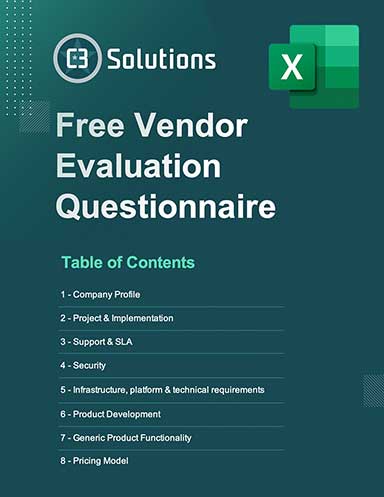Top 10 Supply Chain Software Suppliers 2022
With nearly $10.3 billion in supply chain management revenues for 2021, the leading 10 providers of SCM software topped double-digit growth, growing faster than the overall SCM software market as enterprise leaders looked to tame persistent supply chain disruptions with modern Cloud-based software.
The large-scale disruptions that have beset global supply chains since mid-2020 have been challenging for nearly everyone, but the industry response carries one silver lining: The chaos has nudged, maybe even pushed, more companies into modernizing their supply chain management (SCM) software applications.
Though newer Cloud-based SCM software isn’t a quick fix, ongoing disruption likely has convinced some decision makers that it is time to invest in newer solutions, as evidenced by the high growth year for SCM software in 2021.
According to market research by Gartner Inc., which is the basis for this list of the Top 10 SCM software suppliers, the Top 10 SCM software providers racked up nearly $10.3 billion in software revenue through 2021, up from $9.06 billion in 2020 for the same set of vendors, a gain of close to 14%.
The annual growth rate of the Top 10 SCM software suppliers is slightly higher than that of the overall SCM software market, which grew at 12.5% over the previous year in 2021. That’s up from high single-digit growth in recent years for the overall SCM market with even faster growth in procurement (16%) and SCE (13%) software.
“It’s good to see this level of investment coming back into supply chain management software,” says Balaji Abbabatulla, Gartner UK’s senior director of product management research for SCM software. “It’s also good to see enterprise leaders opening up their minds to working with modern software applications, though in some cases, they are potentially being forced to do so because traditional legacy applications just were not designed for, or prepared to handle, the type and level of disruption that has been thrown at us the last couple of years.”
Multiple drivers are responsible for this uptick, explains Abbabatulla, including the shift to Cloud-based solutions, and newer data-driven application functions with embedded artificial intelligence (AI) that are better able to cope with rapidly shifting demand and supply conditions. With many companies struggling to cope with massive problems, more leaders are likely convinced it’s time to do things differently with better software.
“I think the level of disruption has helped change the mindset of many supply chain leaders in terms of them realizing that some of the existing software they have is just not fit for the purpose any longer,” says Abbabatulla. “These investments that happened in 2021 are long term in nature and won’t immediately solve the big issues around global disruption, but over time, modern applications will have a positive impact, and there are some point solutions that should help resolve certain issues in the short term.”
Top 10 supply chain management software suppliers
SCM (SCE, SCP, Procurement) Total Software Revenue (in millions USD)*
| No. | Supplier | 2020 Revenue |
2021 Revemue |
SCP | WMS** | TMS** | Procurement |
| 1 | SAP | $4,405 | $4,844 | x | x | x | x |
| 2 | Oracle | 1,752 | 1,896 | x | x | x | x |
| 3 | Blue Yonder (previously JDA Software) | 714 | 819 | x | x | x | |
| 4 | Coupa | 458 | 617 | x | |||
| 5 | E2open | 282 | 420 | x | x | ||
| 6 | WiseTech Global | 319 | 413 | x | x | ||
| 7 | Descartes Systems Group | 312 | 381 | x | |||
| 8 | Infor | 333 | 322 | x | x | x | x |
| 9 | Manhattan Associates | 266 | 298 | x | x | x | |
| 10 | GEP | 220 | 285 | x | |||
| Top 10 total | $9,061 | $10,295 | |||||
| Other vendors | $6,640 | $7.36 | |||||
| TOTAL | $15,701 | $17,657 |
Source: Gartner
** Gartner sees WMS and TMS as part of the supply chain execution market, along with distributed order management and global trade management.
About the Top 10 List
This is the 21st time Modern has reported on the supply chain management (SCM) software market from a business standpoint. Although we initially focused on the top providers of warehouse management systems (WMS), we’ve broadened the coverage to also examine solutions such as procurement and transportation management systems (TMS) recognizing that WMS is just one aspect of the SCM market, and that major vendors offer applications that often span more than one niche.
For that reason, Modern looks to Gartner. Our starting point is Gartner’s annual assessment of market share revenue for SCM software providers. It’s a numbers game and not a popularity contest. The rankings are based on Gartner’s estimates of a provider’s SCM revenue for 2021. Importantly, Gartner’s estimates are based on revenues related to SCM software and not a company’s total revenues.
Additionally, Gartner does not include hardware-related revenue in its estimates, and doesn’t look at warehouse execution system (WES) or manufacturing execution system (MES) software in its SCM market study.
Finally, our chart adds columns to indicate whether a vendor offers advanced WMS or TMS solutions, while Gartner’s study groups WMS and TMS under the broader subcategory of supply chain execution (SCE), which also includes distributed order management (DOM) and global trade management (GTM). Thus, while the numbers on our Top 10 table are from Gartner’s SCM research, the WMS and TMS columns are added by Modern, since these solution capabilities are of interest to readers.
Cloud brings change to the Top 10
Compared to recent years, we see a shake-up in the Top 10, with one new entrant, GEP, a procurement software platform provider replacing Jaggaer in the Top 10 SCM provider list. Others fell back, while e2open, which has acquired multiple companies and grew rapidly propelled largely by acquisition, shot up on this year’s list.
All the Top 10 vendors on this year’s list saw a revenue increase for 2021, with the exception of Infor, which experienced a modest decline and dropped down on the list.
A key underlying driver of SCM market share change is the proportion of vendor revenue from Cloud software. With Cloud-based software sales, explains Abbabatulla, the revenue stream recurs over time compared with the one-time revenue model of on-premises software with traditional licensing. Software providers that went all Cloud a few years back have a more predictable revenue base compared with vendors whose sales have been more on-premises focused. With sales of new SCM solutions being increasingly Cloud based in recent years, this has tended to lift the revenue streams for the all-Cloud vendors and dampen the revenue of those vendors who have sold a larger proportion of on-premises, traditional license software over the last few years.
“There’s definitely more change in the list than we have seen in the last few years, especially with Cloud vendors,” Abbabatulla says. “They are the ones who tend to be changing the landscape.”
Procurement leads the growth across SCM market segments
Gartner analyzes SCM software across three sub-segments, procurement, supply chain execution (SCE), and planning (see box, page 46, for more on this breakdown). Across all three segments in 2021, there was stronger growth than in recent years, notes Abbabatulla, with close to 12.5% growth for the overall SCM software market (not just the Top 10) compared to 2020.
All of Gartner’s subcategories grew and did well in 2021, led by procurement and followed by SCE solutions on an overall market basis (not just the Top 10). Supply chain planning (SCP) lagged a bit as a submarket, with about 9% growth for the category, which again, is linked to the higher share of on-premises software support revenue in the SCP software market.
However, Abbabatulla adds, all the top vendors are growing their proportion of Cloud revenue, so the advantage for the all-Cloud first-movers will not last forever. The Top 10 may stabilize in the coming years, he adds, as all the leading vendors are shifting to Cloud software models, which leads to more predictable revenue streams over a longer cycle. This should also help the overall market retain momentum, even in the face of mounting inflation, the war in Ukraine, and other unforeseen risks.
“I don’t expect the supply chain management market to slow down significantly, given that modern supply chain software investments can deliver a competitive advantage to enterprises not just incremental improvements in efficiency or savings, which helps the market retain momentum,” he says.
Data and AI, not business process driven
Another shift in the SCM software market is that the leading vendors offer AI-driven applications that can take in data from within an enterprise, trading partners, or other sources to arrive at better supply chain decisions.
This ends up driving a fundamental shift in the way the software gets implemented and used, in that rather than trying to modify SCM software packages to fit a standard set of business processes aimed at bringing rigor to supply chain operations, SCM software deployments are more about feeding relevant data into the software and letting the AI algorithms come up with insights that are better able to cope with the rapidly changing nature of supply chains, explains Abbabatulla.
“The value of these business applications is not the AI technology itself, but really, how it helps the user companies solve business challenges, whether its forecasting, or transportation decisions based on real-time visibility,” Abbabatulla says.
AI is increasingly embedded in SCM solutions, Abbabatulla says, rather than something that needs to be built from scratch, but the AI engines do need to be fed high quality data from internal and external data sources. As a result, the SCM software space will be less about tinkering with the way software carries out a procedure, and more about improving the quality of data and training the AI algorithms to prescribe better decisions.
“With AI-enabled supply chain management software, the focus changes from process to data,” Abbabatulla says. “Rather than deploying software that conforms to the way the organization has always done things, enterprise leaders will prioritize software that prescribes insights that allow the supply chain organizations to do things better. AI-driven supply chain software is a big shift for users, but more of them will realize that the way supply chain software has been implemented and used in the past isn’t good enough to meet the challenges of today.”













